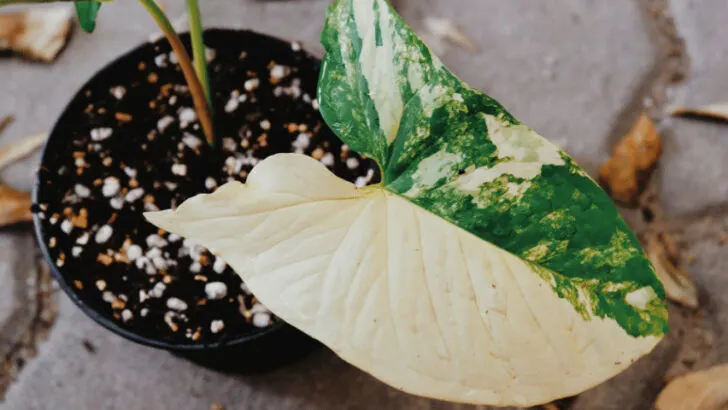Syngonium Albo care. The Syngonium Albo plant is also called the arrowhead plant. It belongs to the Aroid family (Araceae family) of plants. It is an easy plant to care for. The plant is native to Bolivia, Mexico, and Brazil.
Its name means ‘diversity of colors.’ It has lovely white variegation.
Syngonium Albo Care
The Syngonium Albo plant likes bright, filtered sunlight. Water once a week. Humidity should be between 50-60%. The ideal temperature range is 60- 80°F (15°C – 26°C). It prefers fertile soil containing coco coir. Use organic fertilizers once a month.
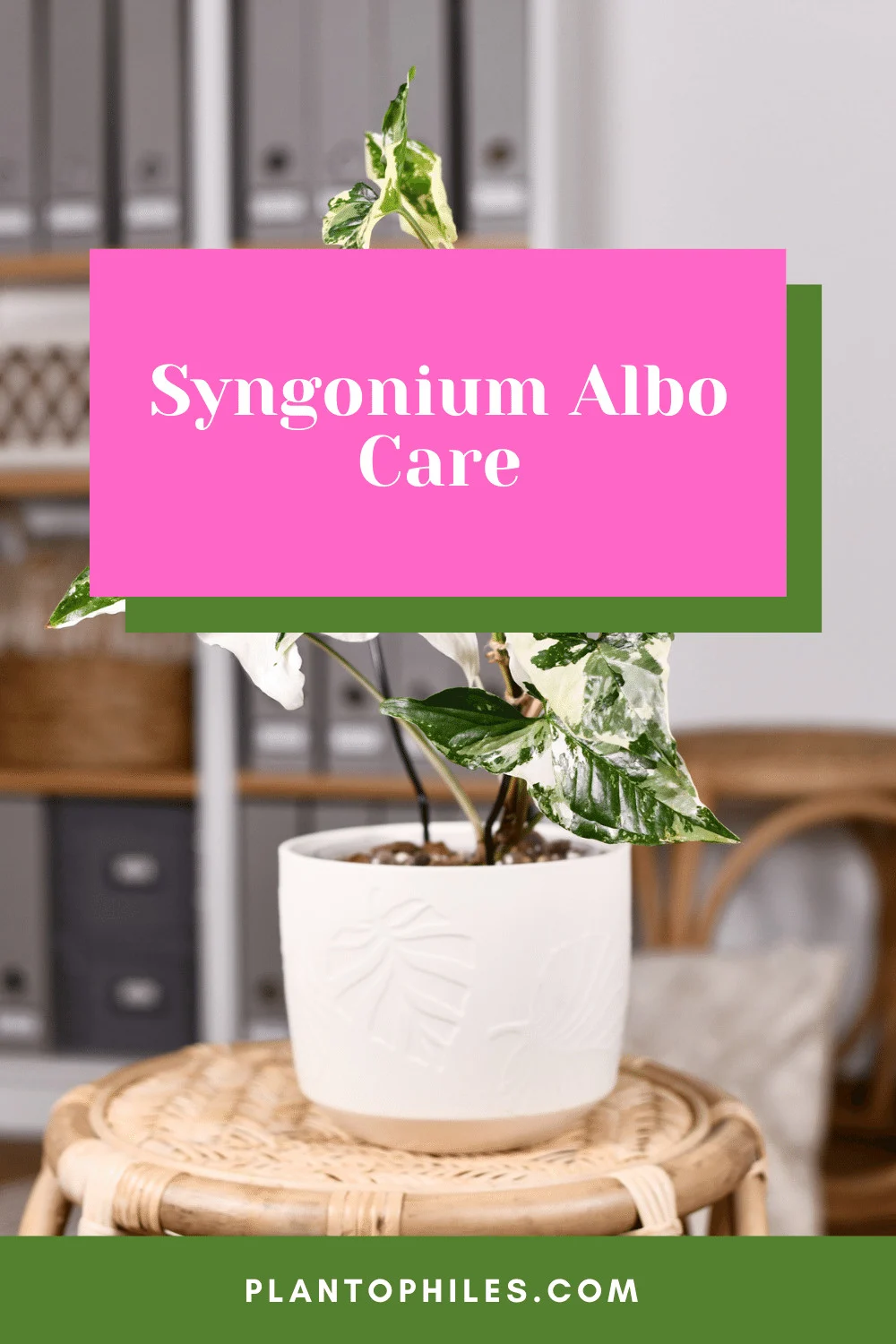
Table of Contents
Syngonium albo soil
This plant thrives in organic, light soils that retain moisture well.
A good choice for the Syngonium Albo plant is a fertile mix of coco coir or 10% – 20% perlite.
The soil must not hold excess water for too long. This leads to various fungal and bacterial infections.
Opt for a general Syngonium plant mix if you cannot find coco coir.
Take one-part houseplant potting soil, one-part orchid bark, and one-part perlite.
Put all these ingredients together for a suitable potting mix.
Water
Water when their soil turns slightly dry about once a week.
The watering routine is highly dependent on the plant’s environment.
If placed indoors, the Syngonium Albo plant requires a lot less water.
On the other hand, the plant needs plenty of water outdoors.
Check if the Syngonium Albo plant’s soil’s top two to three inches are dry with your index finger. Water once this is the case.
Water the plant from the top and cover all areas.
Remove any extra water from the leaves once finished. This will prevent mold.
I also suggest using lukewarm water to prevent shock to the Syngonium Albo root system.
If you have access to extremely hot or cold water, let it sit in a bucket for some time to cool down before watering.
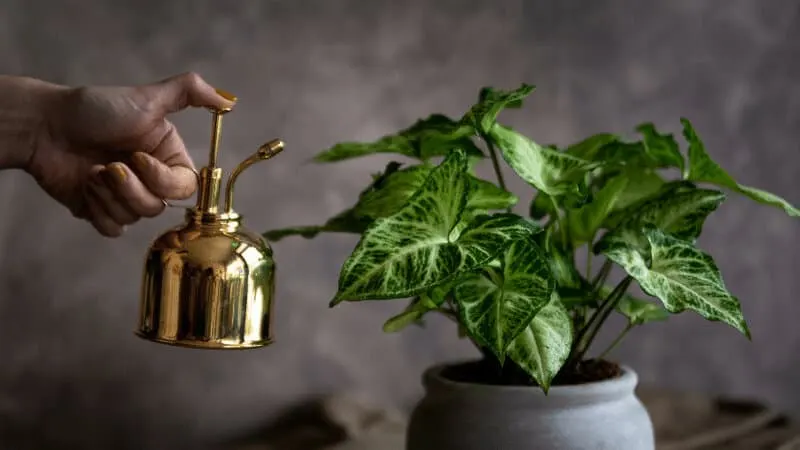
Syngonium Albo Light Requirements
The ideal light indoors is bright indirect light.
If you grow this plant outside it needs shade from neighboring plants, such as trees and larger plants.
This plant naturally grows on forest floors. It, therefore, needs dappled sunlight.
Indoors, the Syngonium Albo plant prefers sunny windows that receive filtered sunlight.
Northeast and west-facing windows primarily work well for the Syngonium Albo plant.
Alternatively, you can place the Syngonium Albo plant under artificial growing lights.
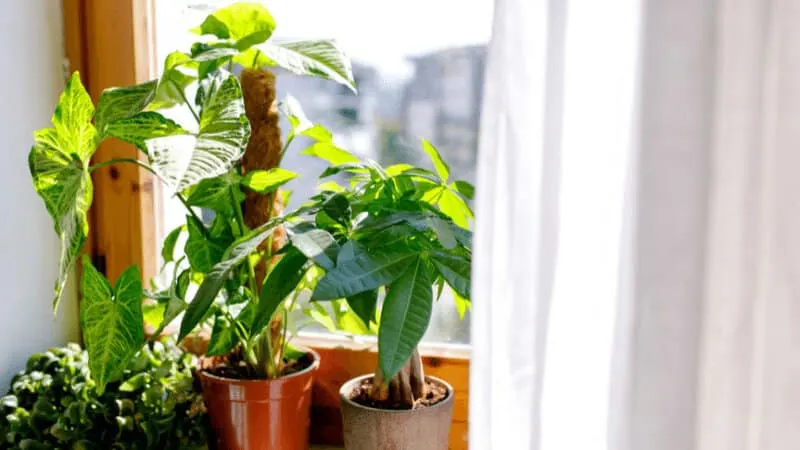
Temperature
The Syngonium Albo prefers a temperature between 60-80°F (15° C – 26° C).
Your Syngonium Albo plant will do just fine if you do not let the temperatures fall below 60 °F (15° C).
Warmer temperatures mean you have to water your plant more often.
Avoid placing your indoor plant directly in front of windows. The wind drafts, especially in autumn and winter, can be too cold. In summer, the heat might be too intense.
Because the microclimate is different directly in front of a window.
Similarly, do not place it too close to air conditioners and heaters.
You can grow Syngonium outside in USDA hardiness zones 9 – 11 in the summers.
Syngonium Albo Humidity
Humidity between 50-60% is sufficient. The higher the humidity is, the better it is for its growth rate. But ensure that there is sufficient air circulation.
The plant leaves need to dry within 30 minutes. Or else they can get bacterial infections.
Fertilizer
Fertilize once a month in spring and summer using an organic fertilizer diluted to 1/2 strength. Do not fertilize in autumn and winter. Your plant is dormant during these seasons. Follow the directions mentioned on the packaging.
You can buy a liquid or slow-release fertilizer. Ensure the fertilizer is well-balanced and contains all the essential macro and micronutrients.
Nitrogen (N), Phosphorus (P), and Potassium (K) is the essential macronutrients.
Magnesium and sulfate are important Micronutrients.
Repotting
The Syngonium Albo plant is moderately sized. Repot it every 2-3 years. It will not need repotting every year.
All you need to do is put it in its desired soil and find the right-size pot.
I recommend using soil mixes with slow-release fertilizer to help the plant adjust to its new pot.
You can use soil mixes that fertilize the plant for about nine months.
You will not have to stress about fertilizer burns as they break down slowly.
Once you are done repotting, leave the plant as it is to give it time to adjust.
Pick a pot with at least three drainage holes so there is minimal risk of root rot.
If you cannot find an appropriate pot, make some holes in a medium-sized pot with a drilling machine.
Take the Syngonium Albo plant carefully from its old pot and put it in its new pot.
Ensure that the roots are spread out evenly and not too compressed over one another.
Similarly, add some water so it has enough moisture as it grows. I discovered that it is best to only water after 24 hours.
The roots might have been damaged from repotting. Watering too early could lead to root rot.
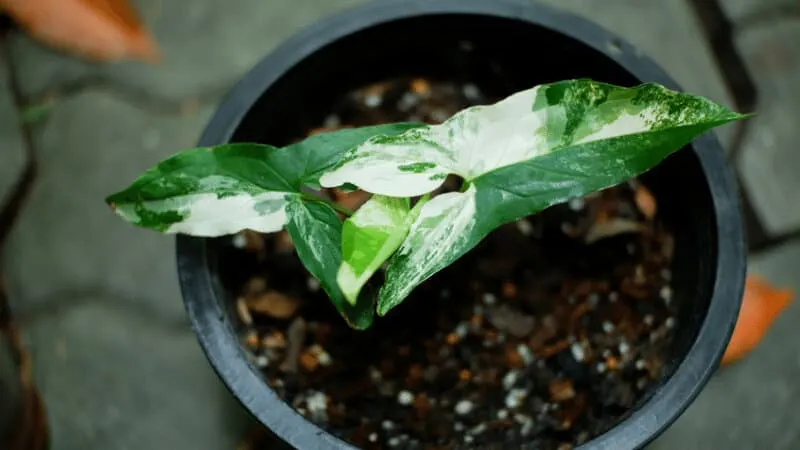
Pruning
Trim the Syngonium Albo plant to keep it looking healthy and in shape. Remove yellow and brown leaves.
Infrequent trimming helps encourage new growth and gets rid of possibly infected parts.
Remove older or diseased stems and let the younger ones stay.
Ensure not to damage any healthy stems while pruning the Syngonium Albo plant.
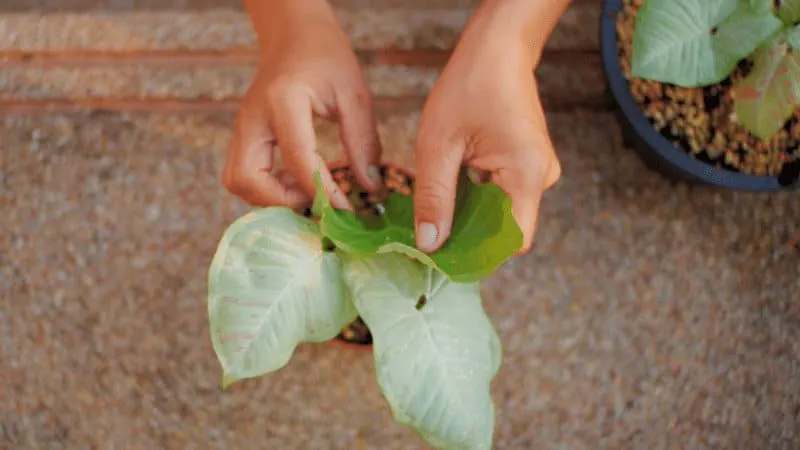
Propagation
Propagating Syngonium Albo is easy. You can propagate it from stem cutting or apical cuttings.
Remove sections from the apical shoots to propagate.
Propagation Step-By-Step
- Take a healthy Syngonium Albo plant and take some cuttings from it close to the roots, at least 3 – 4 inches (7.5-10cm).
- Take this cutting and apply rooting powder to its lower end.
- Put this cutting in a soil mix containing coco coir and perlite.
- You may also add water to keep the plant hydrated after 24 hours.
- Alternatively, you can put the cutting in water.
- Now, wait until you see some roots sprouting, then let the plant grow in the same water for a while.
- Once the plant grows its new leaves and roots, transfer it to a pot and place it in dappled sunlight.
The baby Syngonium Albo plant may take a few weeks to develop. When you see two to three leaves growing, it is growing fine.
Keep a close eye on any signs of infection, as a young plant quickly catches diseases.
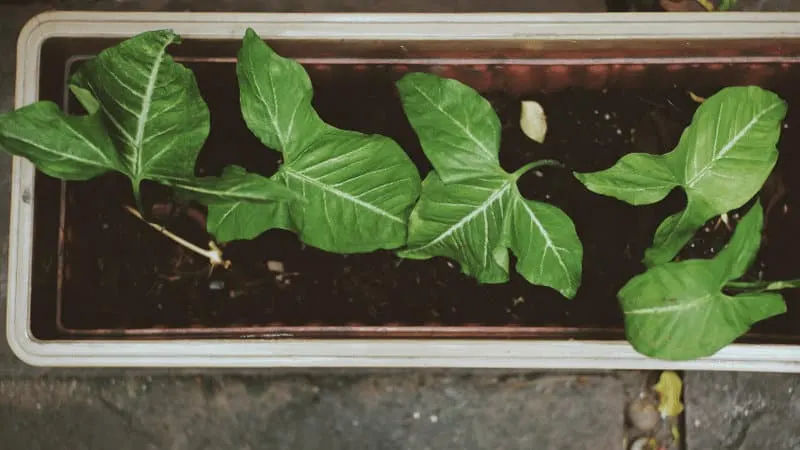
Syngonium Albo Blooms
It grows attractive blooms with snow-white color with some splashes. The flowers are complemented by deep green arrow-like foliage.
Growth
The Syngonium Albo plant’s height also depends on its surroundings. Outdoor plants grow taller than houseplants.
The average size is 6.6 feet (2m) in height and 2 feet (60 cm) spread.
You can put the Syngoniuim Albo plant in a hanging basket or a pot along with a trellis.

Common Diseases and Pest for Syngonium Albo
Yellow Leaves
For several reasons, the leaves of the Syngonium Albo plant can become yellow.
The most significant reasons include overwatering and underwatering. The foliage will not lose color at once but gradually.
The spots then merge, and the whole leave turns yellow eventually.
Look closely at its soil to identify if the plant is yellowing due to an incorrect watering routine.
If it is too dry, you need to increase the watering frequency. Withhold watering if it is wet. Additionally, remove any yellow leaves.
Dry Brown Leaf Tips
The plant’s tips are susceptible to drying. The reason is underwatering.
The tips can also turn crisp if the air is too dry. You can add a humidifier to resolve this issue. Misting plants is not a good idea to increase humidity.
It only increases the humidity for a few minutes, and you also risk bacteria and fungus.
With insufficient airflow, plant leaves cannot stay wet for longer than 30 minutes.
Another reason for dry brown leaf tips is excess sunlight. The ends may dry, or they may turn yellow.
To prevent this, place the Syngonium Albo plant in dappled sunlight only. If your plant is discolored already, cut the affected parts.
Growth Cessation
The Syngonium Albo plant undergoes another issue frequently. Growth cessation.
It can occur due to a lack of fertilizer, insufficient nutrients in the soil, inadequate sunlight, and an incorrect watering schedule.
Identifying the exact problem is tricky as there are many reasons.
Revisit your care routine and ensure that you add the right amount of water and fertilizer at the right time.
It is entirely normal if the plant doesn’t grow in winter.
Brown spots on Syngonium Albo
Brown spots indicate fungal and bacterial growth. The spots are brown and black and can have various sizes. Common bacteria infection Erwinia blight and bacterial leaf spot, according to the University of Kentucky.
Remove diseases leave. Ensure the plant has sufficient airflow. Make sure the soil is not too dense. Do not overwater. Soggy soil encourages bacterial growth.
Pests
Common pests are mealybugs, thrips, scales, whiteflies, fungus gnats, fruit flies, and aphids. Check your plant frequently for pests. Also, have a look at the underside of the leaves.
To counter and prevent plant pests, use horticultural soap and neem oil. If pest infestations are really bad, use a systemic pesticide.
Apply neem oil, soap, and also pesticides multiple times over the span of a few weeks. Do also treat the soil.
Many pests lay eggs in the soil. It takes several weeks until the offsprings emerge. This is why it is important to treat plants multiple times.
An alternative treatment is using beneficial nematodes.
Tips for Growing Syngonium Albo
- Propagate the plant during the spring and summer
- Add chlorine-free, lukewarm water only.
- Use coco coir in the soil to encourage growth.
- Pinch the stems from time to time to limit haphazard growth.
- Maintain the plant’s ideal temperature range for it to flourish fully.
- Place the plant in bright, indirect sunshine to avoid burning and drying the foliage.
Frequently Asked Questions
Why is my Syngonium Albo plant reverting?
If your plant is reverting, move it to a bright spot. Variegated plants need more light compared to non-variegated plants. The white parts cannot absorb any chlorophyll. Also, cut back your plant to where it had the last variegated leaves. This increases variegation.
Why is my Syngonium Albo plant drooping?
The Syngonium Albo plant may droop if its soil is extremely dry. Thoroughly water the plant every time its top 2 – 3 inches of soil turn dry (5-7.5cm). But a thorough soak is a better idea if the soil is dry till the bottom.
How do you encourage variegation on the Syngonium Albo plant?
For beautiful variegation, place the plant in partial to full light in the early morning and late evening hours. Place the plant indoors next to a sunny window or a bright spot to stay healthy.
Syngonium Albo care requires well-draining soil, watering once a week, and temperatures between 60- 80°F (15°C – 26°C).

